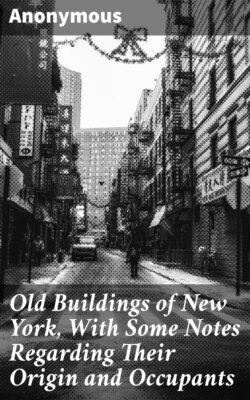Читать книгу Old Buildings of New York, With Some Notes Regarding Their Origin and Occupants - Anonymous - Страница 7
На сайте Литреса книга снята с продажи.
ОглавлениеBank of New York
Table of Contents
The oldest bank in the country is the Bank of North America in Philadelphia, incorporated by act of Congress, December, 1781, and by the State of Pennsylvania a few months afterwards. Very great losses had occurred from the repudiation of the Continental bills of credit. All the States had issued bills of their own and kept on “making experiments in finance which did not depend on specie as a basis.” Currency was expressed in pounds, shillings, and pence and the currency in circulation was a motley conglomeration of guineas, doubloons, pistoles, Johannes pieces, moidores, and sequins. Thus arose the necessity of a bank that should both assist the Government and benefit the people at large.
On February 26, 1784, a meeting of the principal merchants and citizens was held at the Merchants’ Coffee House. General Alexander McDougal was chosen chairman, and it was unanimously decided to establish a bank. Subscription books were opened at the offices of John Alsop, Broadway, Robert Bowne, Queen Street, and Nicholas Low, Water Street, and the shares were rapidly taken.
On March 15, 1784, the following officers were chosen: General Alexander McDougal, president; Samuel Franklin, Robert Bowne, Comfort Sands, Alexander Hamilton, Joshua Waddington, Thomas Randall, William Maxwell, Nicholas Low, Daniel McCormick, Isaac Roosevelt, John Vanderbilt, and Thomas B. Stoughton, directors; and William Seton, cashier.
The bank commenced business at what was formerly the old Walton house in St. George’s (now Franklin) Square. It stood on the east side of Queen (now Pearl) Street, almost opposite the present establishment of Harper Brothers, the publishers. The building (erected 1752) will be remembered by many people to-day as it was only taken down in 1881, but its appearance during its declining years gave a faint idea of its original dignity. In 1787 the business of the bank was moved to Hanover Square, Isaac Roosevelt having been chosen president in 1786.
In 1796 a lot was bought at the corner of Wall and William streets from William Constable for eleven thousand pounds (New York currency). Strange to say, there is no record of the dimensions of the lot, but the present building doubtless stands on part of it.
Early in 1797 steps were taken to remove the house then standing and to put up a new building, and the corner stone was laid by Gulian Verplanck, then president, on June 27th. Mr. Verplanck died in 1799 and Nicholas Gouverneur was chosen president. The corner stone of the present building was laid on September 10, 1856, and the building completed in 1858.11
